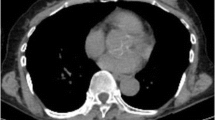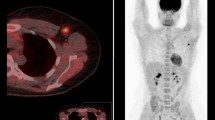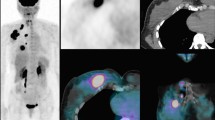Abstract
Purpose
18F-Alfatide II has been translated into clinical use and been proven to have good performance in identifying breast cancer. In this study, we investigated 18F-Alfatide II for evaluation of axillary lymph nodes (ALN) in breast cancer patients and compared the performance with 18F-FDG.
Methods
A total of 44 female patients with clinically suspected breast cancer were enrolled and underwent 18F-Alfatide II and 18F-FDG PET/CT within a week. Tracer uptakes in ALN were evaluated by visual analysis, semi-quantitative analysis with maximum standardized uptake value (SUVmax), mean standardized uptake value (SUVmean), and SUVmax ratio of target/non-target (T/NT).
Results
Among 44 patients, 37 patients were pathologically diagnosed with breast cancer with metastatic (17 cases) or non-metastatic (20 cases) ALN. The sensitivity, specificity, accuracy, positive predictive value (PPV), and negative predictive value (NPV) of visual analysis were 70.6%, 90%, 81.1%, 85.7%, and 78.3% for 18F-Alfatide II, 64.7%, 90%, 78.4%, 84.6%, and 75% for 18F-FDG, respectively. By combining 18F-Alfatide II and 18F-FDG, the sensitivity significantly increased to 82.4%, the specificity was 85%, the accuracy increased to 83.8%, the PPV was 82.4%, and the NPV significantly increased to 85.0%. Three cases of luminal B subtype were false negative for both 18F-Alfatide II and 18F-FDG. The other 2 false negative cases of 18F-Alfatide II were triple-negative subtype and 3 false negative cases of 18F-FDG were luminal B subtype too. The AUCs of three semi-quantitative parameters (SUVmax, SUVmean, T/NT) for 18F-Alfatide II were between 0.8 and 0.9, whereas those for 18F-FDG were more than 0.9. 18F-Alfatide II T/NT had the highest Youden index (76.5%), specificity (100%), accuracy (89.2%), and PPV (100%) among these semi-quantitative parameters. 18F-Alfatide II uptake as well as 18F-FDG uptake in metastatic axillary lymph nodes (MALN) was significantly higher than that in benign axillary lymph nodes (BALN). Both 18F-Alfatide II and 18F-FDG did not show difference in primary tumor uptake irrespective of ALN status.
Conclusion
18F-Alfatide II can be used in breast cancer patients to detect metastatic ALN, however, like 18F-FDG, with high specificity but relatively low sensitivity. The combination of 18F-Alfatide II and 18F-FDG can significantly improve sensitivity and NPV. 18F-Alfatide II T/NT may serve as the most important semi-quantitative parameter to evaluate ALN.






Similar content being viewed by others
References
Kvistad KA, Rydland J, Smethurst HB, Lundgren S, Fjosne HE, Haraldseth O. Axillary lymph node metastases in breast cancer: preoperative detection with dynamic contrast-enhanced MRI. Eur Radiol. 2000;10:1464–71.
Jessing C, Langhans L, Jensen MB, Talman ML, Tvedskov TF, Kroman N. Axillary lymph node dissection in breast cancer patients after sentinel node biopsy. Acta Oncol. 2018;57:166–9.
Zhang X, Liu Y, Luo H, Zhang J. PET/CT and MRI for identifying axillary lymph node metastases in breast cancer patients: systematic review and meta-analysis. J Magn Reson Imaging. 2020;52:1840–51.
Chang JM, Leung JWT, Moy L, Ha SM, Moon WK. Axillary nodal evaluation in breast cancer: state of the art. Radiology. 2020;295:500–15.
Zhao M, Wu Q, Guo L, Zhou L, Fu K. Magnetic resonance imaging features for predicting axillary lymph node metastasis in patients with breast cancer. Eur J Radiol. 2020;129:109093.
Zhou P, Wei Y, Chen G, Guo L, Yan D, Wang Y. Axillary lymph node metastasis detection by magnetic resonance imaging in patients with breast cancer: a meta-analysis. Thorac Cancer. 2018;9:989–96.
Orsaria P, Chiaravalloti A, Caredda E, Marchese PV, Titka B, Anemona L, et al. Evaluation of the usefulness of FDG-PET/CT for nodal staging of breast cancer. Anticancer Res. 2018;38:6639–52.
Song BI, Kim HW, Won KS. Predictive value of 18F-FDG PET/CT for axillary lymph node metastasis in invasive ductal breast cancer. Ann Surg Oncol. 2017;24:2174–81.
Leenders M, Kramer G, Belghazi K, Duvivier K, van den Tol P, Schreurs H. Can we identify or exclude extensive axillary nodal involvement in breast cancer patients preoperatively? J Oncol. 2019;2019:8404035.
Felding-Habermann B, O’Toole TE, Smith JW, Fransvea E, Ruggeri ZM, Ginsberg MH, et al. Integrin activation controls metastasis in human breast cancer. Proc Natl Acad Sci U S A. 2001;98:1853–8.
Chen H, Niu G, Wu H, Chen X. Clinical application of radiolabeled RGD peptides for PET imaging of integrin αvβ3. Theranostics. 2016;6:78–92.
Yu C, Pan D, Mi B, Xu Y, Lang L, Niu G, et al. 18F-Alfatide II PET/CT in healthy human volunteers and patients with brain metastases. Eur J Nucl Med Mol Imaging. 2015;42:2021–8.
Mi B, Yu C, Pan D, Yang M, Wan W, Niu G, et al. Pilot prospective evaluation of 18F-Alfatide II for detection of skeletal metastases. Theranostics. 2015;5:1115–21.
Wan W, Guo N, Pan D, Yu C, Weng Y, Luo S, et al. First experience of 18F-alfatide in lung cancer patients using a new lyophilized kit for rapid radiofluorination. J Nucl Med. 2013;54:691–8.
Luan X, Huang Y, Gao S, Sun X, Wang S, Ma L, et al. 18F-alfatide PET/CT may predict short-term outcome of concurrent chemoradiotherapy in patients with advanced non-small cell lung cancer. Eur J Nucl Med Mol Imaging. 2016;43:2336–42.
Liu J, Wang D, Meng X, Sun X, Yuan S, Yu J. 18F-alfatide positron emission tomography may predict antiangiogenic responses. Oncol Rep. 2018;40:2896–905.
Wu C, Yue X, Lang L, Kiesewetter DO, Li F, Zhu Z, et al. Longitudinal PET imaging of muscular inflammation using 18F-DPA-714 and 18F-Alfatide II and differentiation with tumors. Theranostics. 2014;4:546–55.
Bao X, Wang MW, Luo JM, Wang SY, Zhang YP, Zhang YJ. Optimization of early response monitoring and prediction of cancer antiangiogenesis therapy via noninvasive PET molecular imaging strategies of multifactorial bioparameters. Theranostics. 2016;6:2084–98.
Guo J, Guo N, Lang L, Kiesewetter DO, Xie Q, Li Q, et al. 18F-alfatide II and 18F-FDG dual-tracer dynamic PET for parametric, early prediction of tumor response to therapy. J Nucl Med. 2014;55:154–60.
Dong Y, Wei Y, Chen G, Huang Y, Song P, Liu S, et al. Relationship between clinicopathological characteristics and PET/CT uptake in esophageal squamous cell carcinoma: 18F-Alfatide versus 18F-FDG. Mol Imaging Biol. 2019;21:175–82.
Wu J, Wang S, Zhang X, Teng Z, Wang J, Yung BC, et al. 18F-Alfatide II PET/CT for identification of breast cancer: a preliminary clinical study. J Nucl Med. 2018;59:1809–16.
Zhou Y, Gao S, Huang Y, Zheng J, Dong Y, Zhang B, et al. A pilot study of 18F-Alfatide PET/CT imaging for detecting lymph node metastases in patients with non-small cell lung cancer. Sci Rep. 2017;7:2877.
Guo J, Lang L, Hu S, Guo N, Zhu L, Sun Z, et al. Comparison of three dimeric 18F-ALF-NOTA-RGD tracers. Mol Imaging Biol. 2014;16:274–83.
Fuster D, Duch J, Paredes P, Velasco M, Munoz M, Santamaria G, et al. Preoperative staging of large primary breast cancer with [18F]fluorodeoxyglucose positron emission tomography/computed tomography compared with conventional imaging procedures. J Clin Oncol. 2008;26:4746–51.
Heusner TA, Kuemmel S, Hahn S, Koeninger A, Otterbach F, Hamami ME, et al. Diagnostic value of full-dose FDG PET/CT for axillary lymph node staging in breast cancer patients. Eur J Nucl Med Mol Imaging. 2009;36:1543–50.
Groheux D, Giacchetti S, Moretti JL, Porcher R, Espie M, Lehmann-Che J, et al. Correlation of high 18F-FDG uptake to clinical, pathological and biological prognostic factors in breast cancer. Eur J Nucl Med Mol Imaging. 2011;38:426–35.
Robertson IJ, Hand F, Kell MR. FDG-PET/CT in the staging of local/regional metastases in breast cancer. Breast. 2011;20:491–4.
Pritchard KI, Julian JA, Holloway CM, McCready D, Gulenchyn KY, George R, et al. Prospective study of 2-[18F]fluorodeoxyglucose positron emission tomography in the assessment of regional nodal spread of disease in patients with breast cancer: an Ontario clinical oncology group study. J Clin Oncol. 2012;30:1274–9.
Kitajima K, Fukushima K, Miyoshi Y, Katsuura T, Igarashi Y, Kawanaka Y, et al. Diagnostic and prognostic value of 18F-FDG PET/CT for axillary lymph node staging in patients with breast cancer. Jpn J Radiol. 2016;34:220–8.
Sasada S, Masumoto N, Kimura Y, Kajitani K, Emi A, Kadoya T, et al. Identification of axillary lymph node metastasis in patients with breast cancer using dual-phase FDG PET/CT. AJR Am J Roentgenol. 2019;213:1129–35.
Osborne JR, Port E, Gonen M, Doane A, Yeung H, Gerald W, et al. 18F-FDG PET of locally invasive breast cancer and association of estrogen receptor status with standardized uptake value: microarray and immunohistochemical analysis. J Nucl Med. 2010;51:543–50.
Park HL, Yoo IR, Hyun JO, Kim H, Kim SH, Kang BJ. Clinical utility of 18F-FDG PET/CT in low 18F-FDG-avidity breast cancer subtypes: comparison with breast US and MRI. Nucl Med Commun. 2018;39:35–43.
Seok JW, Kim Y, An YS, Kim BS. The clinical value of tumor FDG uptake for predicting axillary lymph node metastasis in breast cancer with clinically negative axillary lymph nodes. Ann Nucl Med. 2013;27:546–53.
Yoo J, Kim BS, Yoon HJ. Predictive value of primary tumor parameters using 18F-FDG PET/CT for occult lymph node metastasis in breast cancer with clinically negative axillary lymph node. Ann Nucl Med. 2018;32:642–8.
Jung NY, Kim SH, Kang BJ, Park SY, Chung MH. The value of primary tumor 18F-FDG uptake on preoperative PET/CT for predicting intratumoral lymphatic invasion and axillary nodal metastasis. Breast Cancer. 2016;23:712–7.
Can C, Komek H. Metabolic and volume-based parameters of 18F-FDG PET/CT for primary mass and axillary lymph node metastasis in patients with invasive ductal carcinoma: a retrospective analysis in relation to molecular subtype, axillary lymph node metastasis and immunohistochemistry and inflammatory markers. Nucl Med Commun. 2019;40:1051–9.
Arslan E, Cermik TF, Trabulus FDC, Talu ECK, Basaran S. Role of 18F-FDG PET/CT in evaluating molecular subtypes and clinicopathological features of primary breast cancer. Nucl Med Commun. 2018;39:680–90.
Kim JY, Lee SH, Kim S, Kang T, Bae YT. Tumour 18F-FDG uptake on preoperative PET/CT may predict axillary lymph node metastasis in ER-positive/HER2-negative and HER2-positive breast cancer subtypes. Eur Radiol. 2015;25:1172–81.
Funding
This work was supported by the National Key Basic Research Program of China (973 program, 2014CB744504), the National Natural Science Foundation of China (81971675), the Natural Science Foundation of Jiangsu Province (BK20160610), Jiangsu Province Social Development Program (BE2017772), Jiangsu Planned Projects for Postdoctoral Research Funds (1601090C), and the National University of Singapore Start-up Fund (R-180-000-017-133, R-180-000-017-733, R-180-000-017-731).
Author information
Authors and Affiliations
Corresponding authors
Ethics declarations
Conflict of interest
The authors declare no competing interests.
Ethical approval
All procedures performed in studies involving human participants were in accordance with the ethical standards of the institutional and/or national research committee and with the 1964 Helsinki declaration and its later amendments or comparable ethical standards.
Informed consent
Informed consent was obtained from all individual participants included in the study.
Additional information
Publisher’s note
Springer Nature remains neutral with regard to jurisdictional claims in published maps and institutional affiliations.
This article is part of the Topical Collection on Oncology - General
Rights and permissions
About this article
Cite this article
Wu, J., Tian, J., Zhang, Y. et al. 18F-Alfatide II for the evaluation of axillary lymph nodes in breast cancer patients: comparison with 18F-FDG. Eur J Nucl Med Mol Imaging 49, 2869–2876 (2022). https://doi.org/10.1007/s00259-021-05333-z
Received:
Accepted:
Published:
Issue Date:
DOI: https://doi.org/10.1007/s00259-021-05333-z




